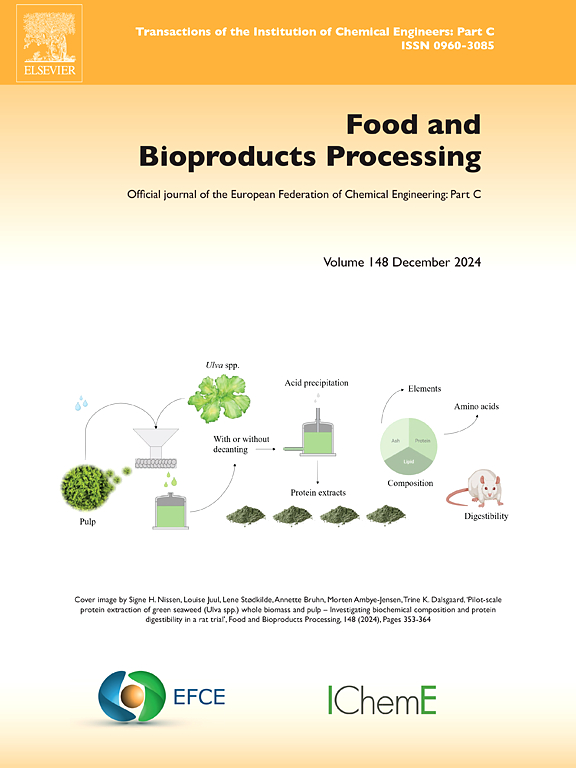建立了一种基于透射光谱的双参数百香果品质预测新方法
IF 3.4
2区 农林科学
Q2 BIOTECHNOLOGY & APPLIED MICROBIOLOGY
引用次数: 0
摘要
本研究旨在利用高光谱透射成像技术同时预测百香果可溶性固形物含量(SSC)和可食性(ER),建立一种无损评价百香果品质的方法。为了克服果实形态的空间异质性,引入遗传算法优化感兴趣区域(ROI)选择和非均匀有理b样条曲线(NURBS)拟合。通过比较多种算法选择关键波长,并评估机器学习模型的预测性能。结果表明,与全区域分析相比,针对SSC和ER定制的ga优化roi显著提高了准确性。波长选择策略存在分歧:SPA优先考虑SSC的近红外波段,而SiPLS强调ER的可见光波段。该方法显著提高了预测精度,其中表现最好的随机森林回归(RFR)模型取得了较好的预测效果(SSC: R2 = 0.922, RMSE = 0.295°Brix; ER: R2 = 0.913, RMSE = 1.166 %)。该研究为厚皮水果的无损质量评价提供了一个有效的框架,对水果行业的自动分选系统具有直接意义。本文章由计算机程序翻译,如有差异,请以英文原文为准。
Developing a novel prediction method for dual-parameter passion fruit quality prediction based on transmission spectroscopy
This study aimed to develop a non-destructive method for assessing passion fruit quality by simultaneously predicting soluble solid content (SSC) and edible rate (ER) using hyperspectral transmittance imaging. To overcome spatial heterogeneity due to fruit morphology, genetic algorithm (GA) optimized region-of-interest (ROI) selection and non-uniform rational B-spline curve (NURBS) fitting were introduced. Key wavelengths were selected by comparing multiple algorithms, and machine learning models were evaluated for prediction performance. Results demonstrated that GA-optimized ROIs tailored to SSC and ER significantly enhanced accuracy over full-region analysis. Wavelength selection strategies diverged: SPA prioritized NIR bands for SSC, while SiPLS emphasized visible bands for ER. The proposed approach significantly improved prediction accuracy, with the best-performing random forest regression (RFR) model achieving superior performance (SSC: R2 = 0.922, RMSE = 0.295°Brix; ER: R2 = 0.913, RMSE = 1.166 %). This study provides an effective framework for non-destructive quality evaluation of thick-skinned fruits, with direct implications for automated sorting systems in the fruit industry.
求助全文
通过发布文献求助,成功后即可免费获取论文全文。
去求助
来源期刊

Food and Bioproducts Processing
工程技术-工程:化工
CiteScore
9.70
自引率
4.30%
发文量
115
审稿时长
24 days
期刊介绍:
Official Journal of the European Federation of Chemical Engineering:
Part C
FBP aims to be the principal international journal for publication of high quality, original papers in the branches of engineering and science dedicated to the safe processing of biological products. It is the only journal to exploit the synergy between biotechnology, bioprocessing and food engineering.
Papers showing how research results can be used in engineering design, and accounts of experimental or theoretical research work bringing new perspectives to established principles, highlighting unsolved problems or indicating directions for future research, are particularly welcome. Contributions that deal with new developments in equipment or processes and that can be given quantitative expression are encouraged. The journal is especially interested in papers that extend the boundaries of food and bioproducts processing.
The journal has a strong emphasis on the interface between engineering and food or bioproducts. Papers that are not likely to be published are those:
• Primarily concerned with food formulation
• That use experimental design techniques to obtain response surfaces but gain little insight from them
• That are empirical and ignore established mechanistic models, e.g., empirical drying curves
• That are primarily concerned about sensory evaluation and colour
• Concern the extraction, encapsulation and/or antioxidant activity of a specific biological material without providing insight that could be applied to a similar but different material,
• Containing only chemical analyses of biological materials.
 求助内容:
求助内容: 应助结果提醒方式:
应助结果提醒方式:


